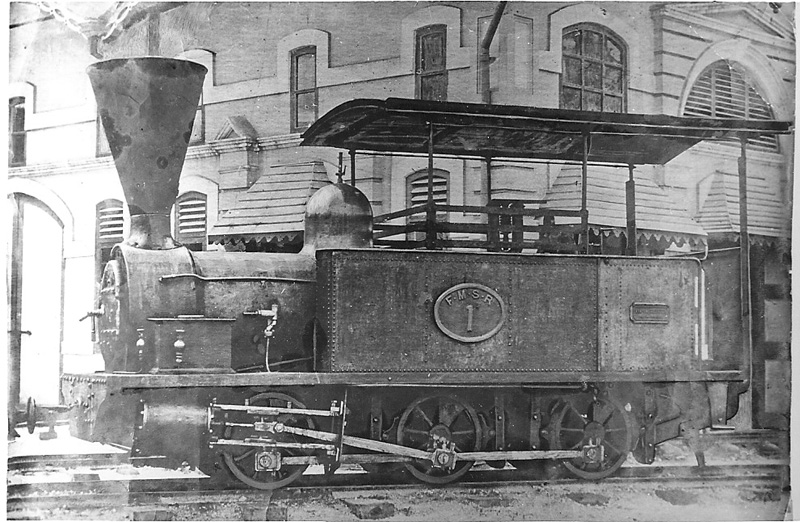
The first locomotives
A small group of individual locomotives which operated the first lines of the FMSR.

Above: FMSR 1 "as built" before conversion to a coal burner. In 1901 the locomotive had a major rebuild at the PGR workshops in Ipoh and a new boiler was ordered identical to the original. This photograph is likely to have been taken after 1903 but before conversion to coal burning and is thought to be at Sentul. Photograph reproduced with permission from the Stephenson Locomotive Society, it is thought to be from the H M le Fleming collection.
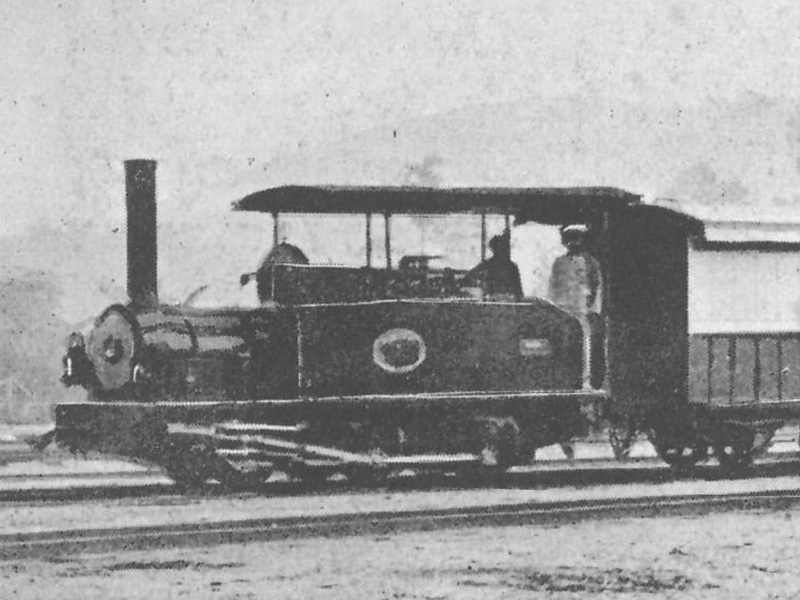
Above: FMSR 1 with a stovepipe chimney. The original photograph was alleged to be taken in 1885 but the plate appears to be FMSR 1 and the stovepipe chimney was probably only fitted after 1903. Since the rest of the stock on the original photograph is early 4-wheelers it is likely to have been taken not long after 1906 when the first bogie coaches were introduced.
Below: The same locomotive with its third-generation chimney, after an interim period with a stovepipe chimney. Photograph reproduced with permission from the Stephenson Locomotive Society, it is thought to be from the H M le Fleming collection.
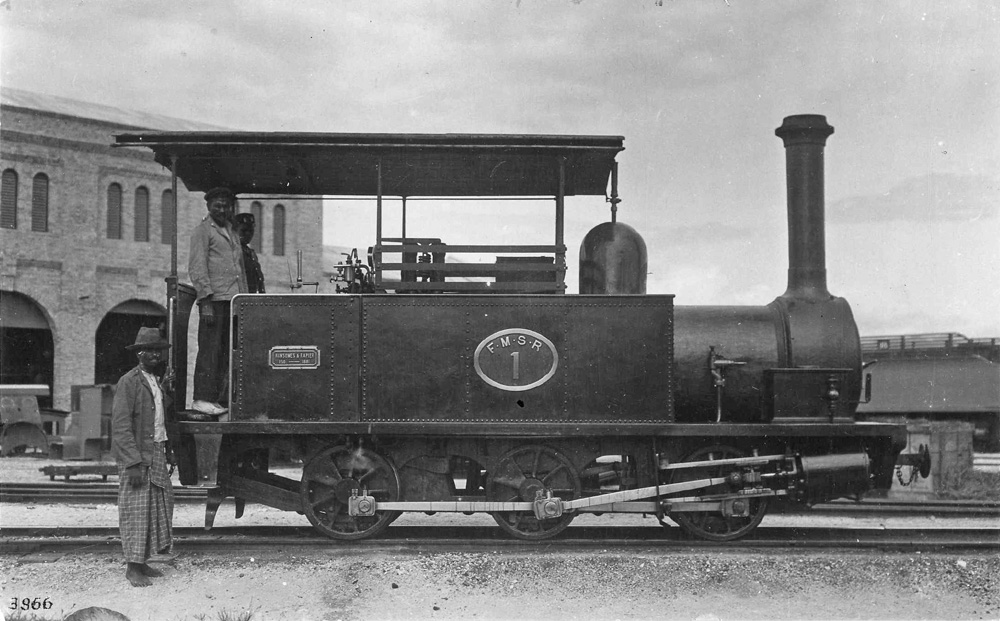
The very first locomotive to enter public service on a railway which became part of the FMSR came from an unlikely source. The Crown Agents (Straits Settlements) placed an order with Ransomes and Rapier on May 18th 1881 for an 0-6-0T locomotive for the Perak Railway. It was similar to their Calcutta class and identified by its order number, 150, and named PERAK. It was the 19th of only 23 steam locomotives built by Ransomes and Rapier and delivered around September 1881, being used for construction work before the line opened, when it became the first locomotive to haul a train on what was to become the FMSR. Ransomes & Rapier also supplied track-work, 10 low-sided goods wagons, locomotive and wagon turntables, station fittings and a 10 ton breakdown crane. Following the formation of the FMSR in 1901 it became No 1 and was later transferred to Sentul as their works shunter, a task it performed until its retirement in 1916. It was cut up in 1920.
Lady Clarke
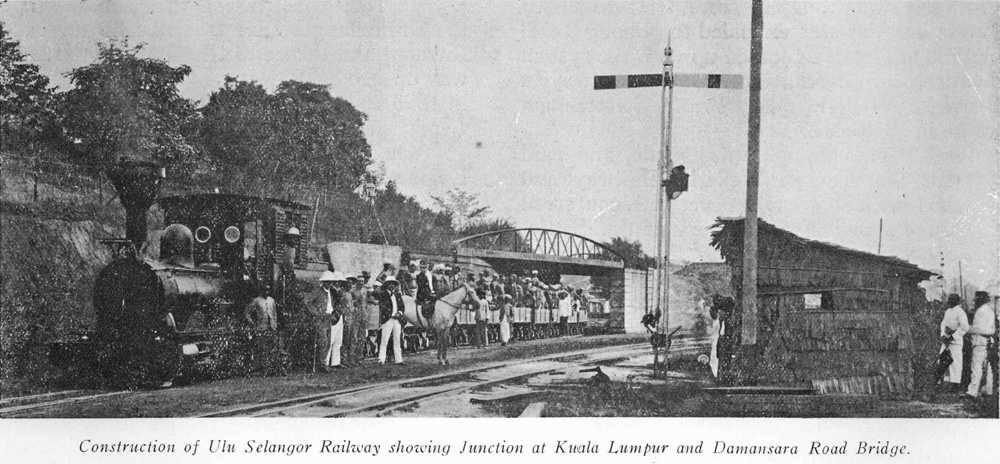
Above: The second locomotive was actually much older than PERAK and arrived in Malaya much earlier. LADY CLARKE was an 0-4-4T, Dübs 742/1874, Indian State Railway B class number 89. In 1875 it was sold to the Maharaja of Johore, possibly for use on the short-lived Johore Wooden Railway, and later arrived on the Selangor Government Railway where it hauled the inaugural passenger train from Klang to Kuala Lumpur on 15th September 1885, being named LADY CLARKE after the wife of the Governor. It was withdrawn in 1893 following a collision but must have been repaired as it went on to become FMSR No 2 in 1901 and survived until scrapping in December 1912.
The third locomotive was R W Hawthorn 2046/1885, an 0-6-0ST with 14" x 20" cylinders and 3' 6" driving wheels, believed to have been named LILY or LILLY while on the Selangor Government Railway. It became FMSR 3 in 1901 and survived until scrapping in August 1924.
In 1888 a metre gauge 0-4-0ST was supplied by Kerr Stuart (at that time known as Dick, Kerr & Co) and sent to Port Dickson on order number 537. It was built by Andrew Barclay as works number 309 and named SUNJEI UJONG, having 9" x 17" outside cylinders and 2' 6½" driving wheels. It later went to the Selangor Government Railway where it is believed to have been named LEILA and in 1901 became FMSR 4. In 1909 it was sold to a contractor for use on the G.K.S. Railway.
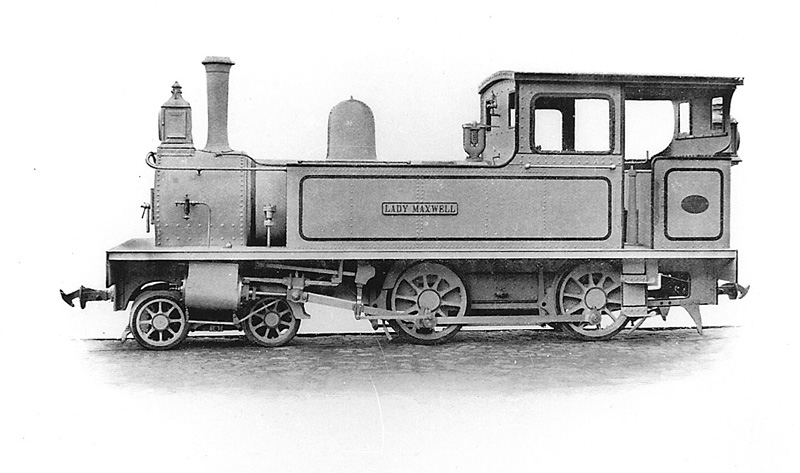
Above: Hudswell Clarke 4-4-0T 364/1890 had outside cylinders 11" x 17" and 3' 3" driving wheels with a rigid wheelbase of 6' 6". The bogie wheels were 2' diameter and the weight in working order was 22 tons. It went to the Selangor Government Railway, possibly as an alternate to the A/B class, and was named LADY MAXWELL. It became FMSR 14 and was scrapped in 1911. Photograph reproduced with permission from the Stephenson Locomotive Society, it is thought to be from the H M le Fleming collection.
0-4-0ST Dick Kerr 59/1893 went to the Selangor Government Railway and was believed to be named SYSYPHUS. It became FMSR 15 in 1901 and was scrapped in 1908.
le Fleming states that although the particulars for FMSR 3, 4 & 15 are correct the order of names are not certain. Note also that the spelling in his 1936 list states LILLY and SYSYPHUS while the 1938 list states LILY and SISYPHUS
Kerr Stuart supplied a metre gauge 0-4-0IST, Bagnalls 1092 of November 1889, to India, with 8" x 12" cylinders and 3' driving wheels. The owner was not identified and it was later used in Malaya - no further details available.
Kerr Stuart also supplied locomotives and equipment for the Penang Steam Tramway. The first locomotive was supposedly from Kitson but their records have no mention of this, although they supplied 16 to the Singapore Tramway in 1885 and 1887. The were two others from Falcon Engine & Car Works in 1885 & 1887 and named JOHORE and SIR HUGH LOWE respectively and another was named PENANG.
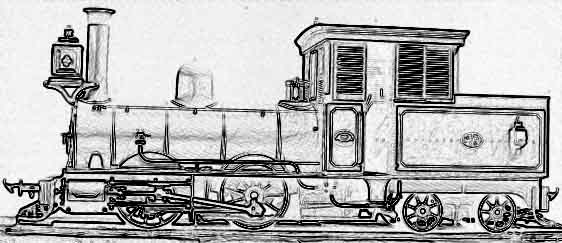
Above:
An Indian State Railway B class, similar to LADY CLARKE.
| Manufacturer | Number | Year | Type | Cylinders |
Driving Wheels |
Name | Notes | Disposal |
| Ransomes and Rapier | 150 | 1881 | 0-6-0T | 9" x 12" oc * | 2' 3" | Perak | (1) became FMSR 1 | Scrapped 1920 |
| Dübs | 742 | 1874 | 0-4-4T | 11" x 18" oc | 3' 6" | Lady Clarke | became FMSR 2 | Scrapped Dec 1912 |
| Falcon Engine | 1885 | 0-4-0Tr | 10" x 14" ic | 2' 6½" | Johore | Dick, Kerr 526? | ||
| Falcon Engine | 134? | 1887 | 0-4-4Tr | Sir Hugh Lowe | (2) Dick, Kerr 532 or 533 | |||
| Andrew Barclay | 309 | 1888 | 0-4-0ST | 9" x 17" oc | 2' 6½" | Sunjei Ujong/Leila | Dick, Kerr 537. Became FMSR 4 | Sold 1909 GKS Rly |
| Bagnalls | 1092 | 1889 | 0-4-0IST | 8" x 12" | 3' 0" | Windsor | Dick, Kerr 54x? | |
| R W Hawthorn | 2046 | 1885 | 0-6-0ST | Lily | became FMSR 3 | Scrapped Aug 1924 | ||
| Hudswell Clarke | 364 | 1890 | 4-4-0T | Lady Maxwell | became FMSR 14 | Scrapped 1911 | ||
| Dick Kerr | 59 | 1893 | 0-4-0ST | Sisyphus | became FMSR 15 | Scrapped 1908 |
(1) As built, boiler pressure 120 psi, weight 10 tons, wheel base 4' 3" + 4' 3".
Rebuilt with new boiler, 9" x 14" cylinders?, weight 13 tons.
(2) Originally suspected typo in KS list, but a line drawing (in the Penang tram book by Ric Francis) shows what appears to be a bogie wheel and it is certainly much longer than Johore.
A (?) indicates some uncertainty regarding the data.
| A & B classes | |||
| Burma E and O | C² class | ||
| H class | |||
| L class | |||
| M class | O class | P class | Mallet |
| Q class | |||
| WWII | Sentinel | WD class |
Page created 24th March 2005.
Updated 11th November 2008.
This page has been visited times